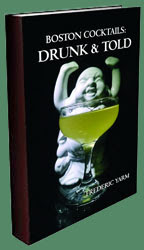 The first talk I attended at Tales of the Cocktail last week was on utilizing citrates to mimic or bolster citrus flavors and crispness in drinks. The talk consisted of Bitter Cube Bitters members Nick Kosevich, Ira Kolowitz, Mike McDonald, and Marco Zappia, as well as Bombay brand ambassador Gary Hayward. The idea for this talk stemmed from the lime crisis of 2014. As availability dropped and prices went up, Marco began to focus on cutting costs such as by peeling limes and creating oleosaccharums to capture lime essences. Once this process started, it led him down the rabbit hole of re-engineering lime juice with acids and balancing with sugar content. It also led to studying when citrus goes bad and how to counteract this.
The first talk I attended at Tales of the Cocktail last week was on utilizing citrates to mimic or bolster citrus flavors and crispness in drinks. The talk consisted of Bitter Cube Bitters members Nick Kosevich, Ira Kolowitz, Mike McDonald, and Marco Zappia, as well as Bombay brand ambassador Gary Hayward. The idea for this talk stemmed from the lime crisis of 2014. As availability dropped and prices went up, Marco began to focus on cutting costs such as by peeling limes and creating oleosaccharums to capture lime essences. Once this process started, it led him down the rabbit hole of re-engineering lime juice with acids and balancing with sugar content. It also led to studying when citrus goes bad and how to counteract this.While citrus is an integral part of many cocktails and mixed drinks (even non-juice ingredients like Campari, vermouth, and gin contain citrus elements), fresh citrus is inconsistent in flavor and cost at different times of the year. Moreover, changes over time after squeezing will create off flavors in the juice. The par system of juicing in advance promotes waste once the excess goes bad; however, squeezing to order is more prone to fruit-to-fruit variation. Here, a mnemonic wrapped in a fart joke was posted "from age, ruined taste and sourness." Fresh citrus has a decay nature with a stunning change occurring over the first 24 hours. Over time, the pH rises, the brix (or sugar content) falls, and organic compounds (such as aromas) change and degrade.

Oleosaccharums are a historical technique dating back to the 17th century to assemble punches. With food oils (such as citrus peel oils) being the "oleo," the sugar being the "saccharum" can extract and stabilize these aromatics. While citrus peels can be placed in sugar for a few hours to extract, this process is sped up in a food processor to chop up the peels into a higher surface area mix. Oleosaccharums are not just for citrus peels but for any high water content fruits such as berries and melons especially those where heat creates off flavors; furthermore, herbs such as mint and rosemary work well in this technique (as long as the mint is removed after 1 hour before it browns and as long as the rosemary is left to extract for longer time periods such as 12+ hours). Oleosaccharums provide for a longer shelf life than pureeing and putting into sugar and alcohol which still allows for degradation.

Citrates are rather important not just in lime crisis but in bottling and kegging cocktails since fruit juice decays over time. In creating a cocktail, 18 brix seemed to be the perfect sugar level. For example, 1.75 parts spirit, 2.75 parts citrate, and 1.25 parts water achieves this ratio. The kegged cocktail has quickly become the modern day punch and offers fast, efficient, consistent, and cost-effective options. Citrates are rather good for carbonation, for unlike juice, they have no sediment that can also act as nucleation points for CO2 gas. In carbonation, very cold starting temperatures are ideal as well as pressurizing and releasing cycles. There are ways of weighing the grams of CO2 per liter, and monitoring this can achieve consistency. Carbonating the whole kit and caboodle also allows for greater carbonation; in certain drinks such as the French 75, only 1/3 to 1/2 of the volume is carbonated, while a carbonated French 75 can be done completely.
 The 2017 collection of 855 drink recipes, bartender tributes, and essays on hospitality from CocktailVirgin's Frederic Yarm. Available at
The 2017 collection of 855 drink recipes, bartender tributes, and essays on hospitality from CocktailVirgin's Frederic Yarm. Available at  The 2012 collection of 505 drink recipes, techniques, and Boston bar recommendations from Frederic Yarm. Available at
The 2012 collection of 505 drink recipes, techniques, and Boston bar recommendations from Frederic Yarm. Available at 




1 comment:
Nice synopsis!
Post a Comment